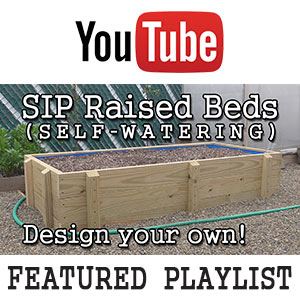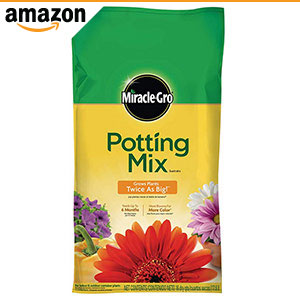SIP Gardening:
What to Expect
So you've finally discovered SIPs! What was it like? When you saw your first soda bottle self-watering planter, did it blow your mind? Yeah, I know! It's such an eye opening experience. That sub-irrigated water reservoir is a game changer in the gardening world!
If you're like me, perhaps you had a flood of ideas and potential applications. I'll never look at a container the same. I'm always looking for cups and pots that just might nest perfectly inside of each other. Here are some designs and tutorials of self-watering SIPs that I've used in my gardening:
- How to Use Wicking Beds in the Garden:
- What Are Self-Watering Planters Good For?
- What Types of Plants Grow Best in Wicking Beds?
- What Limitations Do SIP Planters Have?
- How to Use Sub-Irrigated Planters in the Garden
What Are Self-Watering Planters Good For?
DROUGHT MANAGEMENT: A self-watering container or raised bed planter is perfect for a gardener who is trying to conserve water in a drought ridden climate. In a well watered climate, the ground is able to store tremendous amounts of water from seasonal precipitation. Growing plants right in the ground, perhaps in a normal raised bed, is an easy way to take advantage of naturally occurring rainfalls. Mulching reduces surface evaporation while the ground underneath stays nice and moist.
After extended periods of drought, the scenario can quickly change. Extremely dry soils keep trying to lick up whatever water they can get. Less water goes to your plants and more goes to the parched ground. SIPs create a natural barrier which keeps water in place at the root zone of your garden plants. You only need to supply the water your plants are actually using.
RAIN WATER COLLECTION: Once the ground has formed a dry crust, any subsequent rain event is likely to result in excessive run off. This results in flooding and topsoil erosion while drought conditions are worsened. SIPs are often covered with plastic. Impermeable SIP systems can contribute to more run off.
However, I've had years of growing success without using any impermeable plastic mulch layer. A well designed SIP will be able to absorb natural rainfall without damaging plant health. Once the upper potting mix has reached full saturation, the lower water reservoir will be able to capture potential run off. This allows you to trap and use at least an inch or two of rain water before reaching maximum capacity.
RECLAIM YOUR LAND: The surface of our planet is being smothered by a blanket of brick, concrete and asphalt. As we keep paving over our land, we are losing space for growing our food, especially in urban settings. As with any other container, an SIP system allows us to set up shop in the most unlikely of places. Parking strips, paved lots, sidewalks, rooftops, decks or patios -none of these will stop us! We can grow delicious vegetables on any ground as we simply install self-watering planters or beds, right on top.
What Types of Plants Grow Best in Wicking Beds?
PERFECT FOR ANNUAL VEGETABLES: If you want to grow lush, healthy vegetables that produce the maximum yield, then using an SIP is an ideal way to do so! Tomatoes, peppers, corn, squash, melons, carrots, kale, lettuce. Annual plants are the perfect fit for a self-watering bed or container. They grow for a short time while demanding massive amounts of consistent moisture. That water is, in turn, converted into a bountiful harvest! Once the season is done, the plants can be removed and the potting mix can be refreshed for the next year.
- VEGETABLES THAT GROW WELL IN SIPs:
- Peppers
- Tomatoes
- Ground Cherries
- Watermelon
- Corn (click to learn more)
- Zucchini
- Spaghetti Squash
- Broccoli
- Cauliflower
- Celery
- Kale
- Spinach
- Lettuce
- Arugula
- Radishes
- Carrots
- Parsnips
- Basil
- Parsley
- Dill
What Limitations Do SIP Planters Have?
SELF-WATERING ≠ LAZY GARDENING: The water reservoir in an SIP is a buffer. It reduces plant stress and eases the effort of watering your plants. But that doesn't mean you can or should expect to ignore your plants for weeks on end. Instead, you'll spend less time watering and more time looking at your veggies. Is an aphid colony starting to invade your kale? Get that hose and squirt them off. Are your tomatoes getting big? They might need tied up. Was your corn blown over in a storm? Is your lettuce going to bolt soon? SIPs let you focus on things like these. But they won't automate your gardening, creating a license for neglect.
SPECIAL POTTING MIX REQUIRED: Yes, that's right. You cannot just grab a shovel of dirt from your garden and expect things to grow well in a sub-irrigated planter. You need to follow the basic guidelines of using a good potting mix which has high pore spacing. Healthy plants have healthy roots which require good aeration. Providing this will mean using extra perlite or something similar, such as growstones. Yes, this requires more upfront work and cost. It's worth it, buts it's a con none-the-less.
PERENNIAL FRUITS & HERBS ARE NOT ADVISED: In a temperate climate, SIPs can freeze solid. Herbs and berry bushes make special preparations for cold dormancy in the Winter. The root systems are often where all of the energy is stored until Spring. SIP systems are above ground where it gets colder, reducing hardiness. And they can get waterlogged, causing root death. Never plant Fall time garlic in one of these. Even in the Summer, most Mediterranean herbs prefer drier, well drained conditions. Placing them in an SIP can do more harm than good.
My personal testing is limited to temperate climates. But if you live in a climate which does not experience prolonged Winter-time freezes, then you might have more options. Perennial plantings might be able to thrive. Perhaps things like strawberries or blueberries would work well in an SIP. I haven't tested every scenario. But if your ground never freezes solid, then it might work for you. This would be a great option if you live in an area that is under severe drought stress!
How to Use Sub-Irrigated Planters in the Garden
As long as you understand the pros and cons of a sub-irrigated planter, you'll be able to maintain realistic expectations. These systems might be your sole solution for urban gardening. Or they may simply be one component of a more complex design.
I use my SIPs to pump out huge vegetable yield all Summer long using high density growing techniques. How much produce can you get from vegetable crops grown in SIPs? (Read more here). Then I also grow conventional perennial berry and fruit tree plants in the ground. That's the approach I've been taking and it has been working out great for me!
← READ MORE: SIP Basics
READ MORE: Backyard Orchard Planning →


